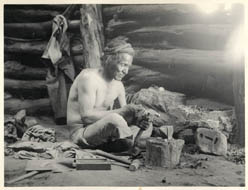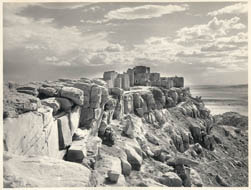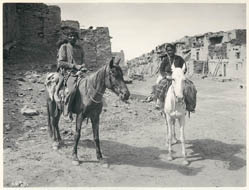Photographing the American Indian:
Portraits of Native Americans, 1860-1913, from the collections of
the Massachusetts Historical Society
The Photographs of Adam Clark Vroman, 1895-1904
Between 1895 and 1904, Adam Clark Vroman photographed the landscape and native peoples of the American Southwest. His photographs of the Hopis, Zunis, and Pueblos, among other tribes, have been praised for their relatively objective eye; as photographic historian Beaumont Newhall wrote in his introduction to Ruth Mahood’s book, Photographer of the Southwest: Adam Clark Vroman, "[he] avoided the sentimental, the contrived, and the obvious. He photographed simply, directly, and sympathetically." Indeed, as the photographs within this web presentation convey, his portraits of Native Americans humanize, rather than romanticize, his subjects. Shown here are a selection of platinotype prints by Adam Clark Vroman in the MHS photograph collection. The platinotype, or platinum print, is known for its non-reflective surface, rich detail, broad tonal range and permanence. The platinum process was patented in England in 1873 and was widely used in the United States and Europe from 1880 through the 1930s, when the cost of platinum became prohibitive and the silver-based processes gained prominence.
About the Photographer
Born in Illinois in 1856, Adam Clark Vroman moved to Pasadena, California in 1892 with hopes that the dry climate would improve his wife's early tuberculosis symptoms. Though Esther Griest Vroman died within two years, Vroman stayed on in Pasadena and opened a book, stationery, and photo-supply shop there in November of 1894. The following year, he began his most significant period of photography, traveling through southern California, Arizona, and New Mexico on seven separate trips from 1895 to 1904 to document the area's landscape, Indians, and Indian communities. He was often accompanied by his friend, Los Angeles Times newspaper editor Charles Fletcher Lummis, who was also an amateur photographer. During 1897 and 1899, Vroman was employed as a photographer by the Bureau of American Ethnology, (a research unit of the Smithsonian Institution) for two separate trips to the Southwest, the former involving a climb to the Enchanted Mesa in central New Mexico to prove the existence of Indian habitation and the latter a documentation of Southwestern pueblos and cliff dwellings.
About the Collector
The platinotypes exhibited here have been selected from the Kingsmill Marrs photographs, a collection held by the Massachusetts Historical Society. Marrs, a Boston collector, amateur photographer, traveler, and writer, most likely bought the albums from Vroman at his bookshop in Pasadena in 1901 or 1902. These photographs were taken by Adam Clark Vroman and are housed in two bound albums and are accompanied by a typescript list of all of the photographs they contain, possibly typed by Vroman or Marrs. Most of the titles listed here for each photograph have been reproduced from that list. Other titles have been derived from published captions in books about Vroman's photography by Ruth Mahood and William Webb (see the bibliography, "Sources for Further Research"). Each photograph is also captioned with Vroman’s original negative number.
The most complete collection of photographs by Vroman is located at the Pasadena Public Library, where 2,400 of his glass plate negatives and 16 volumes of his platinotype prints are stored. For more information about the Adam Clark Vroman photographs at the Massachusetts Historical Society, please refer to the guide to the Kingsmill Marrs photographs.
********** DO NOT EDIT THIS LINE OR BELOW*************
 Woman identified as Nambaya, molding clay pot
Woman identified as Nambaya, molding clay pot
 Two unidentified people free climbing
Two unidentified people free climbing
 Man in hat, identified as Oste
Man in hat, identified as Oste
 Unidentified family: man, woman, and child
Unidentified family: man, woman, and child
 Unidentified woman carrying baby on her back
Unidentified woman carrying baby on her back
 Unidentified man in religious garb
Unidentified man in religious garb
 Unidentified girl standing with bowls
Unidentified girl standing with bowls










